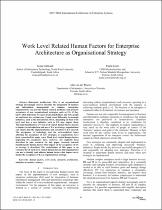 ResearchSpace
ResearchSpace
Work level related human factors for enterprise architecture as organisational strategy
JavaScript is disabled for your browser. Some features of this site may not work without it.
- ResearchSpace
- →
- Research Publications/Outputs
- →
- Conference Publications
- →
- View Item
| dc.contributor.author |
Gilliland, S

|
|
| dc.contributor.author |
Kotzé, Paula

|
|
| dc.contributor.author |
van der Merwe, A

|
|
| dc.date.accessioned | 2016-05-16T10:17:11Z | |
| dc.date.available | 2016-05-16T10:17:11Z | |
| dc.date.issued | 2015-10 | |
| dc.identifier.citation | Gilliland, S, Kotzé, P and van der Merwe, A. 2015. Work level related human factors for enterprise architecture as organisational strategy. 2015 Third International Conference on Enterprise Systems — ES 2015, Basel, Switzerland, 14–15 October 2015 | en_US |
| dc.identifier.isbn | 978-1-4673-8005-8 | |
| dc.identifier.uri | http://ieeexplore.ieee.org/stamp/stamp.jsp?tp=&arnumber=7406847 | |
| dc.identifier.uri | http://hdl.handle.net/10204/8540 | |
| dc.description | 2015 Third International Conference on Enterprise Systems — ES 2015, Basel, Switzerland, 14–15 October 2015 | en_US |
| dc.description.abstract | Enterprise architecture (EA) is an organisational strategy increasingly used to describe the integration of business and information management in complex enterprises. Organisations can prevent human–related problems and promote acceptance of new organisational strategies, such as EA, if they know what behaviour to expect from stakeholders and why people act and react in a certain way. People react differently to strategic initiatives, such as the introduction of EA, depending on their work level and how a new initiative such as EA may impact them. Through identification of work level related human factors known to impact on introduction and use of EA as strategy, organisations can ensure that the implementation and execution of EA succeed. The acceptance of technology and the socio-technical issues affecting the acceptance of new strategies in organisations have been researched for many years. Work level related human factors impacting EA acceptance have, however, not explicitly been described in past research. In this paper, research towards identifying the human factors that impact on the acceptance of EA as strategy is described. The contribution of this paper is an extensive list of work level related human factors that organisations can use to identify and address human factors that impact on or hinder the acceptance of EA as organisational strategy. | en_US |
| dc.language.iso | en | en_US |
| dc.publisher | IEEE | en_US |
| dc.relation.ispartofseries | Workflow;15846 | |
| dc.subject | Acceptance | en_US |
| dc.subject | Enterprise architecture | en_US |
| dc.subject | Enterprise architecture adoption | en_US |
| dc.subject | Human factors | en_US |
| dc.subject | Organisational strategy | en_US |
| dc.subject | Work levels | en_US |
| dc.title | Work level related human factors for enterprise architecture as organisational strategy | en_US |
| dc.type | Conference Presentation | en_US |
| dc.identifier.apacitation | Gilliland, S., Kotzé, P., & van der Merwe, A. (2015). Work level related human factors for enterprise architecture as organisational strategy. IEEE. http://hdl.handle.net/10204/8540 | en_ZA |
| dc.identifier.chicagocitation | Gilliland, S, Paula Kotzé, and A van der Merwe. "Work level related human factors for enterprise architecture as organisational strategy." (2015): http://hdl.handle.net/10204/8540 | en_ZA |
| dc.identifier.vancouvercitation | Gilliland S, Kotzé P, van der Merwe A, Work level related human factors for enterprise architecture as organisational strategy; IEEE; 2015. http://hdl.handle.net/10204/8540 . | en_ZA |
| dc.identifier.ris | TY - Conference Presentation AU - Gilliland, S AU - Kotzé, Paula AU - van der Merwe, A AB - Enterprise architecture (EA) is an organisational strategy increasingly used to describe the integration of business and information management in complex enterprises. Organisations can prevent human–related problems and promote acceptance of new organisational strategies, such as EA, if they know what behaviour to expect from stakeholders and why people act and react in a certain way. People react differently to strategic initiatives, such as the introduction of EA, depending on their work level and how a new initiative such as EA may impact them. Through identification of work level related human factors known to impact on introduction and use of EA as strategy, organisations can ensure that the implementation and execution of EA succeed. The acceptance of technology and the socio-technical issues affecting the acceptance of new strategies in organisations have been researched for many years. Work level related human factors impacting EA acceptance have, however, not explicitly been described in past research. In this paper, research towards identifying the human factors that impact on the acceptance of EA as strategy is described. The contribution of this paper is an extensive list of work level related human factors that organisations can use to identify and address human factors that impact on or hinder the acceptance of EA as organisational strategy. DA - 2015-10 DB - ResearchSpace DP - CSIR KW - Acceptance KW - Enterprise architecture KW - Enterprise architecture adoption KW - Human factors KW - Organisational strategy KW - Work levels LK - https://researchspace.csir.co.za PY - 2015 SM - 978-1-4673-8005-8 T1 - Work level related human factors for enterprise architecture as organisational strategy TI - Work level related human factors for enterprise architecture as organisational strategy UR - http://hdl.handle.net/10204/8540 ER - | en_ZA |





